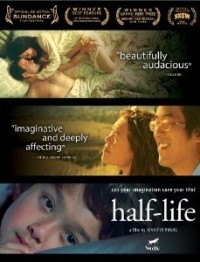
Half Life, Jennifer Phang’s first feature film, envisions a world in which the consequences of disconnection and neglect (at both social and familial levels) are clear.
The drama unfolds in a near-future that‘s characterized by global environmental crises (happening at a rate and scale that seem pre-apocalyptic). While most characters in the film ignore or deny this reality, the film’s central figure, eight-year-old Tim (Alexander Agate), negotiates it by imagining ― and perhaps magically manifesting ― an alternate reality to which he escapes, along with his teenage sister, Pam (Sanoe Lake) and mother (Julia Nickson). Tim has some compelling reasons to want an other-place; like most of the characters in the film, he struggles with isolation and alienation, with fears of abandonment, and with the problem of being not-known or unrecognized by his family members.
Though they all have these troubles in common, the characters don‘t experience them as shared struggles. Their romantic and familial relationships seem to be based on self-interest and a desire for security motivated by fear of loss (this is understandable in some cases, such as Pam and Tim, whose father has suddenly and unexpectedly left the family). Most relationships in the film suffer as parents, friends, or romantic partners do not fully recognize the whole personhood of others ― especially around issues of sexuality, race, and ethnicity. In the worst cases, the lack of recognition leads to violence, emotional abuse, troubling sexual boundary-crossing, and suicidal depression, and in the better ones, to neglect, manipulation, and denial.
Half Life‘s two gay characters do not undergo significant transformations during the course of the film (this is not a coming-out or coming-of-age narrative), and while the ways in which they are mis- or unrecognized are particular, they still find themselves in dysfunctional or damaging relationships with family, friends, and each other. That said, the film has moments of beauty and hope. Its animated sequences, which represent Tim’s fantasy-space, are compelling dream-images. And Agate embodies Tim with great care, giving the most nuanced performance of the film.
Half Life would be a fine addition to film collections in academic and public libraries. Because of sexual scenes in the film, explicit language, the ways in which Tim is unevenly cared-for, and the background story‘s environmental and global disasters, this film is not suitable for children or young adults.
Reviewed by, Alana Kumbier
Wellesley College
